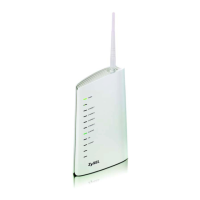Chapter 7 Wireless LAN
P-870HW-51a v2 User’s Guide
76
7.2 What You Need to Know
Wireless Basics
“Wireless” is essentially radio communication. In the same way that walkie-talkie radios send
and receive information over the airwaves, wireless networking devices exchange information
with one another. A wireless networking device is just like a radio that lets your computer
exchange information with radios attached to other computers. Like walkie-talkies, most
wireless networking devices operate at radio frequency bands that are open to the public and
do not require a license to use. However, wireless networking is different from that of most
traditional radio communications in that there a number of wireless networking standards
available with different methods of data encryption.
Wireless Network Construction
Wireless networks consist of wireless clients, access points and bridges.
• A wireless client is a radio connected to a user’s computer.
• An access point is a radio with a wired connection to a network, which can connect with
numerous wireless clients and let them access the network.
• A bridge is a radio that relays communications between access points and wireless clients,
extending a network’s range.
Traditionally, a wireless network operates in one of two ways.
• An “infrastructure” type of network has one or more access points and one or more
wireless clients. The wireless clients connect to the access points.
• An “ad-hoc” type of network is one in which there is no access point. Wireless clients
connect to one another in order to exchange information.
Network Names
Each network must have a name, referred to as the SSID - “Service Set IDentifier”. The
“service set” is the network, so the “service set identifier” is the network’s name. This helps
you identify your wireless network when wireless networks’ coverage areas overlap and you
have a variety of networks to choose from.
Radio Channels
In the radio spectrum, there are certain frequency bands allocated for unlicensed, civilian use.
For the purposes of wireless networking, these bands are divided into numerous channels. This
allows a variety of networks to exist in the same place without interfering with one another.
When you create a network, you must select a channel to use.
Since the available unlicensed spectrum varies from one country to another, the number of
available channels also varies.

